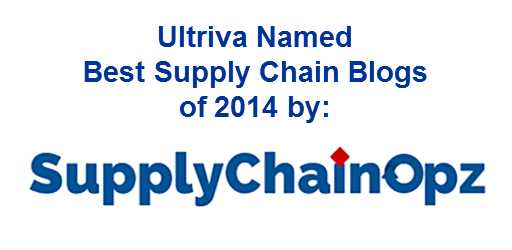This is second in a series of articles by SuppliersOf.com, which is a software evaluation platform with the goal to eliminate the time spent searching for suppliers and to help bullet-proof your supply chain. The company and website was founded on the principles of keeping things as lean as possible and getting features and capabilities out in the market as quickly as possible. Recently, the website wrote the following series of articles to introduce Lean thinking concepts, how they apply to supply chains and how Ultriva’s tools help implement lean ideas and extract value. Here is the second article below.
 Imagine a world where you deliver your final product to your customer after having just completed it, whether this is obtaining it from your suppliers or whether you've just assembled it. In this world its easy to see that shelves and shelves of inventory are only serving as buffers for the incapability of being able to operate just-in-time.
Imagine a world where you deliver your final product to your customer after having just completed it, whether this is obtaining it from your suppliers or whether you've just assembled it. In this world its easy to see that shelves and shelves of inventory are only serving as buffers for the incapability of being able to operate just-in-time.
It sounds far fetched, but this is the ultimate goal of a lean business, which strives to reduce all of the extra capital outlay and wasted effort that carrying inventory entails. Imagine a world where you deliver your final product to your customer after having just completed it, whether this is obtaining it from your suppliers or whether you've just assembled it. In this world its easy to see that shelves and shelves of inventory are only serving as buffers for the incapability of being able to operate just-in-time.
Not carrying any inventory whatsoever is probably beyond our reach for all but the most ephemeral of products, but we can focus on carrying as little as possible while improving fill rates and customer satisfaction.
In this article we continue our exploration of the Ultriva LeanSuite, and focus on the key element that allows you to control your on-hand inventory, and understand your customer demand. Ultriva provides the Collaborative Demand Portal that allows you to work with your customers to help you to get an understanding of demand. It does this by the expedient process of getting your customers to specify their demand.
Understand Demand
Once you have a solid, dependable metric of demand from your customers you know exactly what you need at your distribution center, fulfillment point or sales desk. Working backwards from there you can determine your needs for each step of your process, how much needs to be wrapped by packaging, what production level is needed from manufacturing, how many parts need to be available to manufacturing, how many sub-systems need to be assembled the list goes on.
In any sizable process this becomes very complicated, very quickly and this is where tools like CDP become especially useful. it performs analysis on your demand usage at an individual product level along your entire chain to recommend and adjust inventory levels at each location as demand changes.
The Right Stuff at the Right Time
Improving fulfilment rates not only require the right amount of inventory at the right location but also the capability of being able to execute the process at the right level. If a single process gets backed up the delays have a cascading effect down the chain, for every part that’s delivered late by a supplier multiple dependent manufacturing process all get delayed usually with the delay growing down the chain as people react, report and try to resolve the situation.
Returning to Lean thinking, there are three technical tools that you can employ within your processes to manage both the variability and cycle time of each process. These tools are to control the batch size, monitor the queue size of each process and use cadence to limit variability.
Control your Queues
The size of queues and the effect this has on cycle time was first proven by Prof John Little in 1961 and boils down to the following, the wait time is equal to the queue size divided by the processing rate. This means that the number of items in a queue allows you to know how long your cycle time will be while you’re processing the cycle. It’s a quicker predictor of delays than trying to track waiting times.
When a single process tries to produce multiple of items it introduces a number of risks: variability, cycle time and overhead, usually to gain economy of scale. Usually processes are judged on their per item cost, therefore batch sizes are usually maximized for economy of scale, this approach however completely ignores the holding cost that comes with the increased variability and cycle time. Decreasing the batch size of a process is not as easy as saying all batches should be set to 1, instead it needs to be set at the optimal level to balance holding cost and per item cost to be the most efficient from an overall point of view. This can be found using standard economic order quantity calculations and restricting the scope to a specific process.
Cadence and Synchronization
This approach of looking at a single process in isolation for metrics is also where some of the greatest variability comes from. Consider a sequence of 10 steps in a process, for each step it’s determined that an hour is an acceptable level of variability. The mistake is often made by assuming that this means the whole process will only vary by an hour, assuming that where some steps take a little longer others will be a little quicker. In reality the sequential mechanism actually increases the variability, it’s additive, each step that’s late will increase the likelihood of the next step being late and now your total delay could be as high as 10 hours.
An important method that’s used to reduce the variability in sequential processes is to use Cadence. This is simply to use a rhythm within your process to act as synchronization points. In reality this means that you have defined points either in time or quantity where you force steps to push to the next step. This has the effect of ensuring that even if one step has an unforeseen delay that the remaining steps have limited exposure to the variation that results. Cadence and synchronization is a complicated topic that will be addressed further in a future article.
Demand drives Supply
By understanding demand and getting as close to your customers plans and predictions as possible it allows you to plan your own process to have the right amount of resources at the right time and the right place. Ensuring to closely monitor the queue lengths of the various processes you can react in time to minimize impact, by optimizing the batch sizes of process you can ensure to minimize the risk of queues occurring and by using cadence you limit the variation with the overall process.
In our next article we will look at how you can take the principles of lean beyond your own enterprise and examine how to increase cooperation with suppliers to ensure that your own smooth running lean process is not derailed by late deliveries and how to deal with them when they do occur.
The original article, What if You Never Had to Carry Inventory? appears on the SuplierOf.com website.



